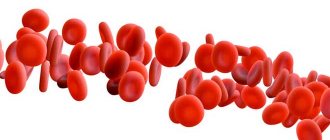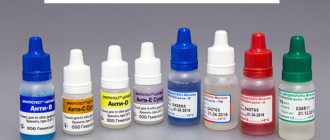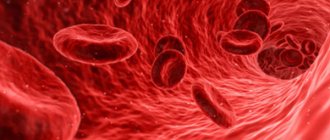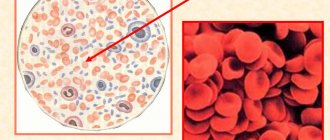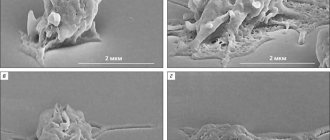The resistance of erythrocytes is understood as their resistance to various destructive factors: mechanical, thermal and others. Of particular importance in laboratory studies is the osmotic resistance of erythrocytes, that is, resistance to hypotonic NaCl solutions of different concentrations. A special test is used to determine at what concentration of sodium chloride the breakdown of red blood cells (hemolysis) begins.
For normal functioning, red blood cells must resist osmotic pressure, that is, they must be strong. The ability to resist is called osmotic resistance, or resistance. If red cells become weak, the immune system marks them as waste material and removes them from the body.
Maximum and minimum resistance are distinguished. The maximum corresponds to the concentration of a hypotonic NaCl solution, at which hemolysis of all red cells occurs within 3 hours. The minimum is determined by the concentration of the solution at which the least resistant red blood cells are destroyed.
What is saline solution?
Saline solution is distilled water with table salt dissolved in it. A saline solution with a concentration of 0.85 percent is called isotonic. There is no destruction of red blood cells in it.
If the salt concentration is lower, the solution is called hypotonic, if higher, it is called hypertonic. When placed in such solutions, red blood cells begin to break down. In hypertonic, or hyperosmotic, they lose water and shrink. When hypotonic, or hypoosmotic, they absorb water and swell.
How to study the ORE
To determine the osmotic resistance of red blood cells, observations are made of the reaction of blood and sodium chloride solution. These ingredients are mixed in equal proportions.
If the concentration of a sodium chloride solution is 0.85%, then it is called isotonic (or saline). At a lower salt content, the chemical is called hypotonic, and at a higher salt content, it is called hypertonic. In an isotonic solution, red blood cells are not destroyed, in a hypotonic solution they swell and disintegrate, and in a hypertonic solution they shrink and die.
How is the analysis carried out?
To test the osmotic resistance of erythrocytes, a hypotonic NaCl solution of different concentrations (from 0.7% to 0.22%) is placed in test tubes. The same amount of blood is added to each tube, usually 0.02 ml. The solution is kept at room temperature for an hour, after which it is centrifuged and the beginning of red blood cell destruction and complete hemolysis are determined by the color of the solution. If the solution turns slightly pink, this indicates the beginning of destruction. When completely disintegrated, the solution acquires a bright red color.
As a result, two parameters are obtained - maximum and minimum resistance, which is expressed as a percentage.
We advise you to read: How long do red blood cells live?
What is ORE
REM is the resistance of red blood cells to destructive factors: high or low temperature, chemicals, and mechanical stress. Typically, laboratory experiments reveal the resistance of red blood cells to sodium chloride (NaCl). During the experiments, it is important to find out what concentration of this chemical causes the destruction of red blood cells. This helps to identify the resistance of blood cell membranes to pressure and the chemical effects of a saline solution (osmosis). Normal red blood cells can resist. They remain strong and their shells remain intact. This is called the osmotic resistance of red blood cells.
The immune system is able to identify blood cells that are weak and cannot resist attack. Over time, these red blood cells leave the body.
Reasons for deviation from the norm
There are many reasons for deviations from the norm. Maximum resistance (below 0.32%) is observed with:
- thalassemia;
- some cases of polycythemia;
- hemoglobinopathies;
- splenectomy;
- massive bleeding;
- congestive jaundice;
- hemoglobinosis;
- atherosclerosis;
- malignant tumors of the gastrointestinal tract.
Behavior of red blood cells in hypertonic, isotonic and hypotonic solutions
The minimum osmotic resistance (above 0.48%) is associated with:
- with hemolytic anemia of newborns;
- with lead poisoning;
- with hereditary hemolytic anemia.
A slight decrease may occur under the following conditions:
- tuberculosis;
- leukemia;
- liver cirrhosis;
- some cases of polycythemia.
The reasons for the decrease in osmotic resistance also include:
- the presence of spherical red blood cells in the blood, which is genetically determined;
- heart failure, in which red cells swell and take on a spherical shape, which shortens their life expectancy;
- aging of red blood cells, the final stage of their life, during which they acquire a spherical shape, while the permeability of their walls increases significantly.
To the osmotic resistance of erythrocytes
Let's return to red blood cells. What happens if you take blood in a test tube and add distilled water to it? Then the reverse process will occur. The environment inside the red blood cells is the same as in the body, 0.85% sodium chloride. Externally, in distilled water - 0%. Therefore, distilled water very quickly enters the red blood cells to equalize the concentration inside and outside.
The cells gradually swell, absorbing water, become spherical, and finally burst. So-called hemolysis occurs, and the blood becomes clear. There are no red blood cells there anymore. All their membranes are destroyed, and the hemoglobin pigment is dissolved in water. This type of blood is called “varnish” because it closely resembles reddish varnish.
If you place red blood cells in a hypertonic solution, then, on the contrary, it will suck all the water out of them, and they will eventually shrivel, like those same tomatoes. We all know that hypertonic dressings with a solution of strong table salt, when placed on purulent wounds, help cleanse them, since they take away all the wound discharge, and rinsing inflamed and loose tonsils with sore throats with salt water reduces swelling and pain. It is on such simple principles that this analysis is built.
Osmotic resistance of erythrocytes is that extremely low concentration of table salt in the blood at which blood cells are not yet destroyed. If this concentration is slightly reduced, then all the cells burst and hemolysis occurs. If the osmotic resistance of red blood cells is high, then hemolysis will occur when the salt concentration in the diagnostic solution is low enough: the cell membranes are healthy and stubbornly resist dilution.
If the resistance of red blood cells is poor, then a slight decrease in the concentration of table salt in the solution will cause their destruction. From this we can draw a simple but important conclusion. If the cell membrane of red blood cells is defective, synthesized “with defects,” then the resistance will be lower than that of healthy blood cells. This means that this simple analysis makes it possible, if not to determine, then to suspect hereditary blood diseases, for example, various types of hemolytic anemia, thalassemia, and other diseases.
Signs of impaired osmotic stability
Symptoms of such a deviation are as follows:
- increased body temperature, sometimes to high values;
- fast fatiguability;
- poor appetite;
- general weakness;
- pallor of the mucous membranes;
- weight loss;
- drowsiness.
Spherocytes (spherical red blood cells) are less resistant to osmotic pressure
Examination methods
More often, an examination is organized using a unique technique to establish the stability of L.I. Idelson. The reagent becomes a 10% solution. Store it in a container with a lid in the refrigerator for several months.
The solution is diluted ten times with distilled water, and from it many workers of different concentrations are made - 100 ml each, also, if necessary, put in the refrigerator, can be used in the next 2 weeks.
Equipment will also require a 37 degree thermostat and a photoelectric colorimeter.
In a person with normal health, blood hemolysis begins at 0.5-0.45%, complete breakdown is noted at 0.4-0.35%.
This research method is implemented in the case of a high probability of detecting hemolytic anemia. Then hemolysis occurs at a concentration of 0.75-0.7%.
A decrease in resistance is observed in hereditary anemia and autoimmune anemia. An increase occurs against the background of thalassemia, obstructive jaundice.
There are other modifications to the study of normal cell stability, namely:
- Visual method of scientists Ribier and Limbeck. For diagnosis, you need to add 20 ml of capillary blood to test tubes that already contain 10 ml of NaCl solution. The mixture is left for an hour at a temperature of 15-25 degrees. The solution is then centrifuged for 3 minutes at 2000 rpm. Only then does the laboratory assistant begin to establish the minimum and maximum resistance. This method requires a considerable volume of blood, its main disadvantage is its low accuracy and non-compliance with generally accepted standards.
- Colorimetric method. It involves direct detection of the concentration of hemoglobin produced by red blood cells during hemolysis. NaCl solution is first placed in test tubes, then red blood cells. Then, using Sali's hemometer, the hemoglobin content is calculated and a hemolysis curve is drawn. This method retains the disadvantages of the previous one.
- Mixing erythrocytes and solution in a spectrophotometer, recording optical density. The wavelength is approximately 650 nm, the temperature in the room is 20 degrees. The main disadvantage is the need to use special equipment.
- Registration of the optical density of a saline solution when a light wave with a length of 650-750 nm passes through it. Diagnostics takes only a few minutes.
There is also a more improved method of L.I. Idelson. To do this, you need 3 test tubes - each containing 0.01 ml of blood. It is centrifuged for 10 minutes, and then using a spectrograph and a wavelength of 414 nm, the light absorption of the liquid above the sediment is assessed. This method helps reduce the labor intensity of analysis and reduce the cost of laboratory containers. But it also has a minus - the intensity of absorption changes under the influence of different forms of hemoglobin.
Carrying out
Detection of RPE is carried out by adding the same volume of blood, usually 0.22 ml, to a solution of varying concentrations - from 0.7 to 0.22%. After 60 minutes of incubation, the mixture is centrifuged. The color of the liquid indicates the onset of hemolysis and then its complete completion.
At the very beginning the liquid is light pink. A rich shade indicates the completion of the breakdown of red blood cells. The results are recorded in two numbers – minimum and maximum resistance.
Dependence of resistance on the shape and maturity of the erythrocyte
Osmotic resistance depends on the shape and age of the cells. Normally, red blood cells have a low sphericity index, but blood may contain spherical elements that are less resistant to destruction. With this form, resistance is significantly reduced, which in this case is 0.4-0.6% when the norm is 0.32-0.44. The spherical shape may be hereditary. In addition, it is observed in cells that complete their life cycle.
Resistance rate
The norm of the BRE indicator does not depend on the age and gender of the patient. A slight decrease in this value is observed in older people, and an increase in children under 2 years of age.
The norm for osmotic resistance of erythrocytes is considered to be the maximum - from 0.32 to 0.34% and the minimum - from 0.46 to 0.48%.
This means that normal red blood cells exhibit the greatest stability in a solution with a concentration of 0.32 - 0.34%, and the least in 0.43 - 0.48%.

